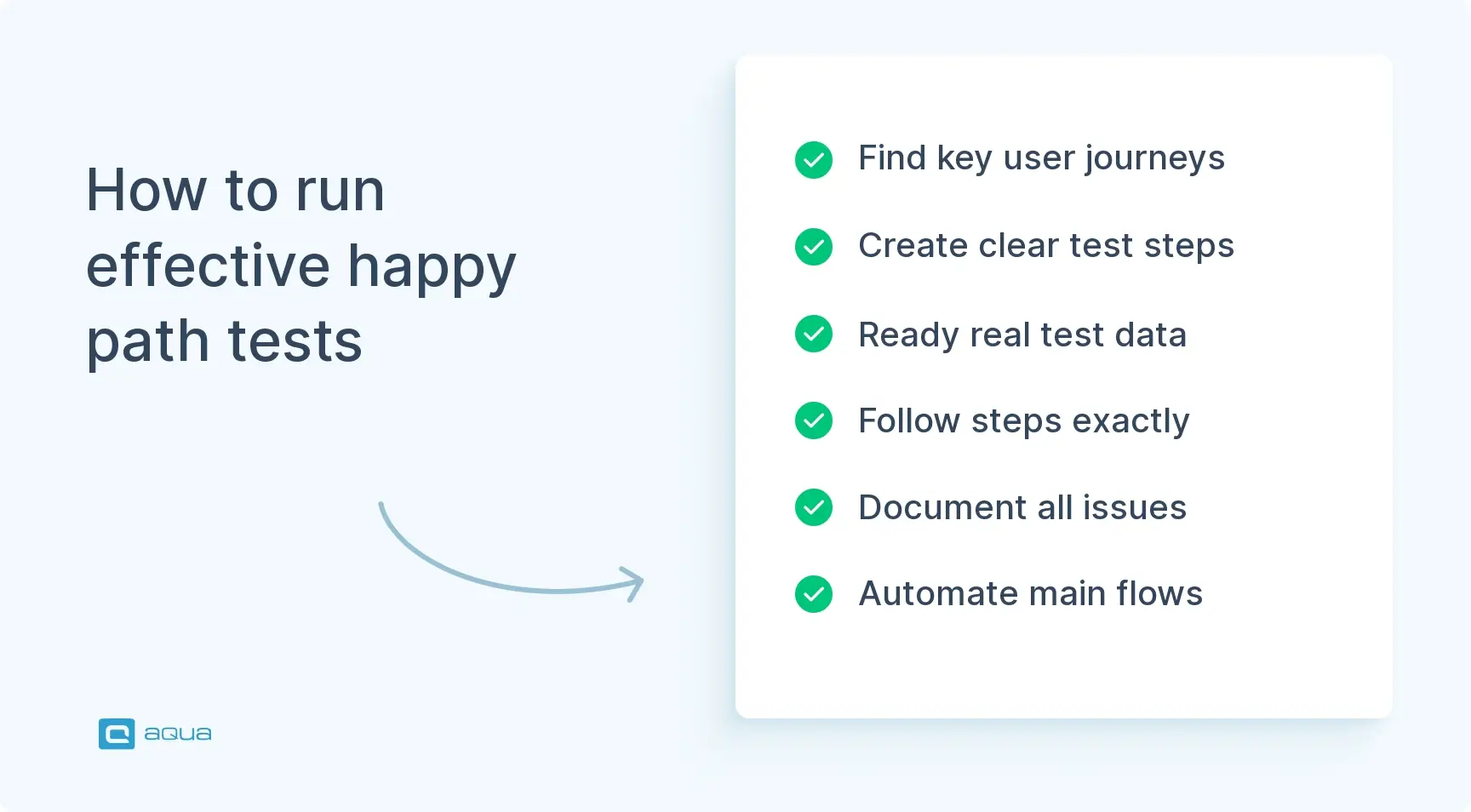What is Happy Path Testing?
Happy path testing is a software testing approach that focuses on validating a system’s behaviour under ideal conditions. It’s testing the most common and straightforward user journeys when everything goes right – no errors, no unexpected inputs, just smooth sailing from start to finish.
Think of it as testing the “sunny day scenario” – the default flow that most users will follow when using your application correctly.
For example, in a login feature, the happy path would be:
- User enters a valid username
- User enters the correct password
- User clicks the login button
- System successfully authenticates the user
- User accesses their account dashboard
This testing confirms that when users do exactly what’s expected, the application responds correctly. It’s the baseline verification that your core functionality works as designed.
Common Happy Path Examples
Let’s look at some more examples to make it even clearer for you:
- E-commerce checkout: User browses products → adds item to cart → enters valid shipping details → provides valid payment info → completes purchase → receives order confirmation
- User registration: User enters valid email → creates password meeting requirements → submits form → receives confirmation email → verifies account
- Social media post: User composes message → attaches media → adds location → tags friends → publishes post → sees post in their timeline
Notice how each path represents the ideal flow with no errors or exceptions? That’s the essence of happy path testing – verifying that your application can handle its primary purpose.
What is the opposite of happy path testing?
The opposite of happy path testing is commonly known as “unhappy path” or “sad path” testing. While happy path testing verifies that a system works correctly under ideal conditions, unhappy path testing deliberately explores what happens when things go wrong.
Unhappy path testing involves:
- Testing with invalid or unexpected inputs
- Verifying error handling and validation
- Checking system behaviour during failures or exceptions
- Testing boundary conditions and edge cases
- Simulating user mistakes or uncommon actions
Consider our login example again. The unhappy paths would include scenarios like:
- What happens when a user enters an invalid username?
- How does the system respond to an incorrect password?
- What if the user tries to submit with empty fields?
- How does the system handle a locked account or too many failed attempts?
- What occurs if the connection drops mid-authentication?
These “rainy day scenarios” are equally crucial for building robust applications. You should cover your application’s functioning from both scenarios – when everything goes right and when everything goes wrong.
So both testing approaches complement each other – you need both to create a truly reliable system.
Happy Path Testing vs. Other Testing Types
Understanding how happy path testing fits into your broader testing scope helps create a comprehensive QA strategy. For this, you should fully understand its characteristics and how it differs from the other testing types. Let’s explore the key differences first.
Happy Path Testing vs. Positive Testing
Many confuse these terms because of their names, or use them interchangeably, but there’s a meaningful distinction:
Happy Path Testing: Focuses exclusively on the most common, expected user journey through a feature when everything works perfectly. It’s limited to the default workflow most users follow.
Positive Testing: Holds a broader range of valid inputs and scenarios that should produce successful results. This includes the happy path but also other, less common valid variations.
For example, when testing a password field:
- Happy path: Testing with a typical valid password like “Password123!”
- Positive testing: Testing multiple valid password variations, including minimum/maximum length passwords, different character combinations, etc.
All happy path tests are positive tests, but not all positive tests are happy path tests.
Happy Path Testing vs. Negative Testing
From the naming, it’s obvious that they are different, but differences do not only come from the names. Let’s see how these two represent opposite testing approaches:
Happy Path Testing: Tests the application when everything goes right (valid inputs, expected flows)
- Expects successful outcomes
- Verifies primary functionality works
- Confirms the “best case” scenario
Negative Testing: Tests the application when things go wrong (invalid inputs, error conditions)
- Expects failure responses or error handling
- Verifies robust error management
- Confirms the application fails gracefully
| Testing Type | Purpose | Focus | Example (Login Form) | Expected Result |
|---|---|---|---|---|
| Happy Path | Verify core functionality works | Main user flow with valid inputs | Enter correct username & password | Successful login |
| Positive | Verify all valid variations work | All valid input combinations | Login with email instead of username | Successful login |
| Negative | Verify proper error handling | Invalid inputs & edge cases | Enter incorrect password | Error message & login denied |
The strongest testing strategies combine all three approaches. Happy path testing provides quick confidence in core functionality, positive testing ensures all valid scenarios work, and negative testing confirms the application handles errors gracefully.
I mean, if the ‘happy path’ is failing, the component isn’t working at all. The QA didn’t make the component. Although in some software development, test cases are created before the component, and they are purposely ‘failed’ until they pass, to indicate completion. Agile.
Importance of Happy Path Testing
Now comes the practical part. Why should happy path testing be a priority in your QA strategy? There are several compelling reasons:
Establishes a Baseline of Functionality
Happy path testing is where quality assurance truly begins. Think of it like turning the key in a new car, not to admire the interior or test the top speed, but simply to make sure it starts and drives. In the same way, happy path tests confirm that the most essential parts of your application work as intended. They show that users can complete key tasks, that core workflows are functional, and that the software is meeting its primary business goals. When these tests pass, they give teams the green light to dig deeper. But if they fail, it’s a clear red flag; one that says there’s no point in testing edge cases or advanced features until the basics are back on track.
Early Detection of Critical Issues
Happy path tests are usually the first stop in any testing cycle, and for good reason. They’re designed to catch the kind of issues that can bring everything to a standstill. If something’s broken in the core functionality, you want to know it right away. These tests surface the bugs that would impact the majority of users, the ones that stop people from logging in, completing a purchase, or submitting a form. By running them early, you give developers fast feedback on whether the basics are holding up. And if a build fails here? That’s your cue to pause deeper testing and focus on fixing what really matters, before wasting time chasing smaller issues.
Supports Continuous Integration/Continuous Delivery
In modern CI/CD pipelines, happy path tests have a clear, practical role. They’re usually the first thing that runs after a new build; quick checks that confirm the basics are still working. If something fundamental breaks, these tests catch it before anyone wastes time on deeper testing. They’re also often used as guardrails: if a happy path test fails, the build doesn’t move forward. Simple as that. It’s a fast, reliable way to know whether the code is even worth looking at.
Improves User Experience and Business Outcomes
From a business point of view, happy path testing is more than just about the code; it’s more about protecting what matters most. It confirms that the key user journeys, the ones people rely on every day, actually work. Think checkout flows, signup processes, account logins; the interactions that drive revenue and shape first impressions. When those paths fail, users notice immediately, and the damage to trust (and conversion rates) can be hard to undo. Most people won’t venture into edge cases because they’ll take the straightforward route. Making sure that the route is smooth is always a good business.
As we explore the critical importance of happy path testing, it’s clear that having the right tools can make all the difference in efficiently validating your core user journeys. A test management system can help you streamline the whole journey by giving you a centralised repository, generative capabilities, and higher coverage.
This is where aqua cloud shines as your comprehensive test management solution. With aqua’s AI-powered test case generation, you can describe your happy path scenarios in plain language and instantly receive detailed, ready-to-execute test steps, saving hours of manual documentation work. The platform’s intuitive step designer allows your team to create, organise, and reuse test steps across multiple scenarios, ensuring 100% coverage of those critical happy paths. Plus, aqua’s centralised repository, you can have full control over your manual and automated tests and ensure your most important user journeys are always tested first, especially under tight deadlines. Why struggle with spreadsheets or basic tools when you could be streamlining your happy path testing with a solution designed to make quality assurance effortless?
Validate 100% of your critical user journeys in half the time with AI-powered TMS
How to Conduct Happy Path Testing Effectively
Following a structured approach ensures your happy path testing delivers maximum value. Here’s a step-by-step guide to conducting effective happy path testing:
1. Determine Your Happy Paths
Start with the primary user journeys through your application lifecycle management:
- Review user stories and requirements to understand expected behaviours
- Identify the most common paths users will take to accomplish tasks
- Focus on core functionality that represents the application’s primary purpose
- Consult with stakeholders to confirm which flows are most critical
For each feature, document the exact sequence of steps that represents the ideal user journey.
2. Generate Clear Test Cases
For each happy path, develop detailed test cases that specify:
- Preconditions (what must be true before the test begins)
- Specific steps to follow in sequence
- Test data to use (valid inputs that represent typical usage)
- Expected results at each step and for the overall flow
Each test case should be clear enough that different testers would execute it the same way. When preparing happy path test cases, ensure they cover all core user journeys without becoming overly complex.
3. Prepare Your Test Environment
Ensure your testing environment is properly configured:
- Set up the application in a stable environment
- Prepare test data that represents real-world usage
- Configure any integrations needed for end-to-end testing
- Ensure test accounts have appropriate permissions
4. Execute Happy Path Tests
Run through each test case methodically:
- Follow the predefined steps exactly
- Use the specified test data
- Observe the system’s behaviour at each step
- Document any deviations from expected results
While executing tests, pay attention to both functionality and user experience aspects. Software testing happy path flows should identify any obstacles that might disrupt the user’s journey.
5. Document and Report Results
Record the outcomes of your happy path testing:
- Document which paths passed or failed
- Capture screenshots or recordings of failures
- Note any unexpected behaviour, even if the end result was successful
- Prioritise issues based on their impact on core functionality
6. Automate Where Possible
Consider automating your most critical happy path tests:
- Focus on automating stable, frequently used paths first
- Include happy path tests in CI/CD pipelines as smoke tests
- Update automated tests when the application changes
- Use automation to quickly verify builds before deeper testing
A well-executed happy path testing strategy provides confidence that your application’s core functionality works as expected, setting the foundation for more extensive testing. When developing unit test happy path scenarios, focus on the core functionality of individual components before moving to integration tests.

Best Practices and Tips for Happy Path Testing
Happy path testing works best when it’s baked into your process early and run often. Don’t wait until a feature is polished; once it’s stable enough to click through, that’s your signal to start testing the main flows. These checks should run on every new build, ideally automated and plugged into your CI pipeline. They are the fast sanity checks that tell you whether your core product is still functioning after each change. The earlier you catch a broken login, a failed checkout, or a missing confirmation screen, the cheaper and faster it is to fix.But running tests isn’t enough. They need to reflect reality. That means using real-world scenarios, data your users would actually enter, and testing on the platforms they rely on. Automation can handle the routine flows efficiently, but don’t overlook manual testing either; it’s often the only way to catch subtle UI issues or broken UX moments. Collaborate with product, dev, and support teams to make sure your happy path tests are rooted in actual user behaviour, not just technical assumptions. And once those core flows are covered, don’t stop. Use them as a launchpad for negative testing, edge cases, and performance checks. Happy path testing gives you confidence that the essentials are working, but quality lives in the details beyond it.
Challenges and Pitfalls to Avoid in Happy Testing
While happy path testing is valuable, being aware of its limitations and common mistakes will help you create a more robust testing strategy. Let’s analyse them one by one, with a simple step solution to avoid them.
Overreliance on Happy Path Testing
- The pitfall: Testing only the happy path creates a false sense of security. Your application might work perfectly in ideal conditions but fail spectacularly in real-world usage.
- How to avoid it: Always complement happy path testing with negative testing, edge cases, and exploratory testing. For each happy path, identify at least 2-3 related unhappy paths to test.
Assuming Users Will Follow the Expected Path
- The pitfall: Users rarely behave exactly as you expect. They skip steps, use features in unexpected ways, and find creative paths through your application.
- How to avoid it: Observe real user behaviour through analytics, usability testing, or support tickets to identify actual paths users take. Test variations of the happy path that reflect real usage patterns.
Testing in Isolation
- The pitfall: Testing features in isolation might miss integration issues that appear when components work together in real-world scenarios.
- How to avoid it: Include end-to-end happy path tests that cross multiple features and components. Test complete user journeys rather than just individual features.
Not Updating Happy Path Tests
- The pitfall: As applications evolve, happy paths change. Using outdated test cases wastes time and misses actual issues.
- How to avoid it: Review and update happy path test cases whenever features change. Treat test maintenance as an essential part of the development process.
Ignoring Performance and Security
- The pitfall: A feature might work functionally, but still fail users if it’s too slow or insecure. Functional-only happy path testing misses these issues.
- How to avoid it: Include performance and security considerations in your happy path testing. Verify that the happy path works at expected load levels and doesn’t introduce security vulnerabilities.
Creating Overly Complex Test Cases
- The pitfall: Happy path test cases should be straightforward. Adding too many steps or variations complicates testing and blurs the line between the happy path and other testing types.
- How to avoid it: Keep happy path test cases focused on the most direct route through a feature. Use separate test cases for variations or edge cases.
Common Testing Blind Spots
Be particularly vigilant about these areas that happy path testing often misses:
- Error handling and recovery
- Input validation edge cases
- Performance under load or stress
- Accessibility considerations
- Cross-browser and cross-device compatibility
- Security vulnerabilities
- Interrupted workflows (what happens if a user stops mid-flow and returns later?)
Being aware of these challenges will help you a lot down the way. By actively working to address them, you can ensure that your happy path testing contributes to overall quality without creating blind spots in your testing coverage.
Conclusion
So, what we learned in this article is that happy path testing forms the foundation of a solid testing strategy by confirming that your application’s core functionality works as expected under ideal conditions. It’s your first line of defence against critical bugs that could prevent users from completing essential tasks.
When implemented effectively, happy path testing helps you quickly catch showstopper issues and confirm that core user journeys work as intended. It provides confidence that each new build covers the basics and makes it easier to move forward without fear of breaking key flows. This kind of validation supports continuous integration and delivery by keeping the feedback loop fast and focused. Ultimately, it also contributes to better user satisfaction as it ensures that the most common scenarios feel smooth and reliable.
However, as we’ve explored, happy path testing alone isn’t enough. It should be the starting point rather than the entirety of your testing approach. Complement it with negative testing, edge cases, exploratory testing, and specialised testing types like security and performance.
Now that you understand the importance of happy path testing in your overall quality strategy, it’s time to elevate your approach with tools that match your testing ambitions. Aqua cloud offers a complete platform that transforms how teams handle both happy path and negative testing scenarios. With aqua’s AI Copilot, you can generate comprehensive test cases in seconds rather than hours, ensuring no critical path goes untested. The platform’s parameterisation capabilities let you easily create variations of your happy path tests, expanding coverage without duplicating effort. When requirements change – as they inevitably do – aqua’s traceability features help you quickly identify which test cases need updating, maintaining the integrity of your test suite. Teams using aqua report saving up to 97% of time spent on test case creation and management, allowing them to focus on discovering the bugs that matter most. Ready to make your happy path testing more efficient, comprehensive, and insightful?
Achieve 100% coverage of critical user journeys with 97% less effort using aqua cloud


















